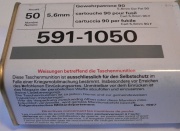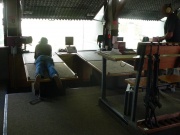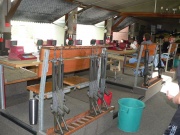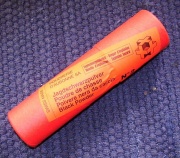Gun politics in Switzerland
| This page is part of a series on
| |
| Gun politics | |
|---|---|
|
| |
| |
Australia |
| |
Brazil |
| |
Canada |
| |
Czech Republic |
| |
Finland |
| |
Germany |
| |
Honduras |
| |
Italy |
| |
Jamaica |
| |
Kuwait |
| |
Mexico |
| |
New Zealand |
| |
Norway |
| |
Pakistan |
| |
South Africa |
| |
Switzerland |
| |
United Kingdom |
| |
United States |
The gun policy in Switzerland is unique in Europe. The personal weapon of militia personnel is kept at home as part of the military obligations. This, in addition to liberal gun laws and strong shooting traditions, has led to a very high gun count per capita. Switzerland has one of the highest gun ownership rates in the world. In recent times political opposition has expressed a desire for tighter gun regulations[1] but a February 2011 national referendum saw 20 out of 26 cantons reject the proposed new gun control schemes[2].
Contents[hide] |
Army issued arms
The Swiss army has long been a militia trained and structured to rapidly respond against foreign aggression. Swiss males grow up expecting to undergo basic military training, usually at age 20 in the Rekrutenschule (German for "recruit school"), the initial boot camp, after which Swiss men remain part of the "militia" in reserve capacity until age 30 (age 34 for officers). Each such individual keeps his army-issued personal weapon (the Sig 550 5.56x45 mm assault rifle for enlisted personnel, the SIG 510 battle rifle and/or the SIG-Sauer P220 9 mm semi-automatic pistol for officers, medical and postal personnel) at home with a specified personal retention quantity of government-issued personal ammunition (50 rounds 5.56 mm / 48 rounds 9mm), which is sealed and inspected regularly to ensure that no unauthorized use takes place.[3]
When their period of service has ended, militiamen have the choice of keeping their personal weapon and other selected items of their equipment. In this case of retention, the rifle is sent to the weapons factory where the fully automatic function is removed; the rifle is then returned to the discharged owner. The rifle is then a semi-automatic or self-loading rifle.
The government sponsors training with rifles and shooting in competitions for interested adolescents, both male and female.
The sale of ammunition — including Gw Pat.90 rounds for army-issue assault rifles — is subsidized by the Swiss government and made available at the many shooting ranges patronized by both private citizens and members of the militia. There is a regulatory requirement that ammunition sold at ranges must be used there. However, pro-gun advocates David Kopel and Stephen D'Andrilli claim "the rule is barely known and almost never obeyed".[3] Indeed, while the sale of non-hunting ammunition is registered at the dealer if purchased at a private store, ammunition purchased at a shooting range is not. Non-military ammunition for long-gun hunting and .22 Long Rifle (LR) ammo is not subsidized, but is not subject to sales controls.[3]
The Swiss Army maintains tight adherence to high standards of lawful military conduct. In 2005, for example, the Swiss prosecuted recruits who had reenacted the torture scenes of Abu Ghraib, one of the charges was improper use of service weapons.
In 2001 Swiss citizen Friedrich Leibacher entered a regional Swiss parliament building and used an assault rifle to kill 14 people before killing himself.[4] Strangely enough, this wasn't his personal army issue weapon, but a private version of the army issue rifle. He committed suicide with a pistol and used an improvised explosive device.[5]
It is claimed that approximately 300 deaths per year involve the use of Swiss army guns, mostly suicides and family murders.[6] As a result of this and similar media reports, gun control advocates are trying to halt the practice of military weapons issuance and storage in the private homes of Swiss Army members. Gun supporters question the statistics and the practice has become a political issue. As of October 2007, the issuing of personal ammunition after boot camp has been discontinued and a majority of the already issued packs will be withdrawn within 2008.
Number of guns in circulation
In some 2001 statistics, it is noted that there are about 420,000 assault rifles stored at private homes, mostly SIG 550 types. Additionally, there are some 320,000 assault rifles and military pistols exempted from military service in private possession, all selective-fire weapons having been converted to semi-automatic operation only. In addition, there are several hundred thousand other semi-automatic small arms classified as carbines. The total number of firearms in private homes is estimated minimally at 1.2 million to 3 million.[7]
Carrying guns
To carry firearms in public or outdoors (and for an individual who is a member of the militia carrying a firearm other than his Army-issue personal weapons off-duty), a person must have a Waffentragschein (weapon carrying permit), which in most cases is issued only to private citizens working in occupations such as security.
It is, however, quite common to see a person serving military service to be en route with his rifle.
Conditions for getting a Carrying Permit
There are three conditions:
- fulfilling the conditions for a buying permit (see section below)
- stating plausibly the need to carry firearms to protect oneself, other people, or real property from a specified danger
- passing an examination proving both weapon handling skills and knowledge regarding lawful use of the weapon
The carrying permit remains valid for a term of five years (unless otherwise surrendered or revoked), and applies only to the type of firearm for which the permit was issued. Additional constraints may be invoked to modify any specific permit. Neither hunters nor game wardens require a carrying permit.
Transporting guns
Guns may be transported in public as long as an appropriate justification is present. This means to transport a gun in public, the following requirements apply:
- The ammunition must be separated from the gun, no ammunition in a magazine.
- The transport has to be direct, ie:
- For courses or exercises hosted by marksmanship, hunting or military organisations,
- To an army warehouse and back,
- To and from a holder of a valid arms trade permit,
- To and from a specific event, e.g. gun shows.[8]
Buying guns
To purchase a firearm in a commercial shop, one needs to have a Waffenerwerbsschein (weapon buying permit). A permit allows the purchase of three firearms. Everyone over the age of 18 who is not psychiatrically disabled (such as having had a history of endangering his own life or the lives of others) or identified as posing security problems, and who has a clean criminal record can request such a permit. The sale of automatic firearms and selective fire weapons is forbidden (as is the sale of certain disabled automatic firearms which have been identified as easily restored to fully automatic capability), unless the buyer has a special collector's license.
To buy a gun from an individual, no permit is needed, but the seller is expected to establish a reasonable certainty that the purchaser will fulfill the above-mentioned conditions. The participants in such a transaction are also required to write down a contract detailing the identities of both vendor and purchaser, the weapon's type, manufacturer, and serial number. The law requires the written contract to be kept for ten years by the buyer and seller. The seller is also required to see some official ID from the purchaser, for such sales are only allowed to Swiss nationals and foreigners with a valid residence permit, with the exception of those foreigners that come from certain countries (Croatia, Bosnia, Macedonia, Turkey, Sri Lanka, Albania, Algeria), to whom such sales are not allowed even if they do have a residence permit. Foreigners without a residence permit or from countries on the ban list must ask for a special permit.
After turning 18, any individual can buy singleshot or semiautomatic long arms (breech-loading or muzzle-loading) without a permit. Likewise, members of a recognized rifle association do not need a buying permit for purchasing antique repeaters, and hunters do not need one for buying typical hunting rifles.
Most types of ammunition are available for commercial sale, including full metal jacket bullet calibres for military-issue weapons; hollow point rounds are only permitted for hunters. Ammunition sales are registered only at the point of sale by recording the buyer's name in a bound book.
These rules will be changed — presumably in 2008 — because Switzerland will be joining the Schengen treaty; and all member countries must adapt some of their laws to a common standard. Following the draft of the Swiss government for the new Waffengesetz (weapons law), these points will change:
- Unlawful possession of guns will be punished;
- Gun trade among individuals will require a valid buying permit (under today's law, persons with a criminal record can trade guns);
- Every gun must be marked with a registered serial number;
- Airsoft guns and imitations of real guns will also be governed by the new law;
Buying ammunition

The government subsidizes the production of military ammunition and then sells the ammunition at cost. Swiss military ammo must be registered if bought at a private store, but need not be registered if bought at a range. Registration consists of entering your name in a log at the time of sale. No serial numbers are present on the individual cartridges of ammunition. Technically, ammunition bought at the range must be used at the range, but according to David Kopel "the rule is barely known and almost never obeyed."[3] Ammunition for long gun hunting is not subsidized by the government and are subject to no sales controls. Non-military non-hunting ammunition more powerful than .22 LR (such as custom handgun ammunition) is registered at the time of sale.[9]
Recreational shooting
Recreational shooting is widespread in Switzerland. Practice with weapons is a popular recreation, and is encouraged by the government, particularly for the members of the militia.[10] Swiss firearms-related rights are supported by the organization ProTell.
200,000 people attend the annual Feldschiessen weekend, which is the largest rifle shooting competition in the world.[3][11] Hunting rifles have special exemptions under Swiss law. Purchases from dealers of hunting long guns and of small bore rifles are not even recorded by the dealer. In other words, the dealer would not record the sale of a .30-06 hunting rifle, but would record the sale of a .30-06 M1 Garand rifle.[3] According to chapter 2 article 10 of Swiss law, people over the age of 18 do not need a permit to purchase a rifle for use in hunting, off-duty shooting and sport-shooting events.[9]
In addition, there are several private shooting ranges that rent guns. It is possible to go shooting with minimal supervision and without an id-check.
Black powder
In Switzerland people can freely purchase black powder in gun shops for use in firing historical rifles. The buyer must merely inform the vendor as to name and address. The Swiss pyrotechnics artist Roman Signer has used this provision of the law to create an explosive "installation" consisting of several miles of fuse wire and heaps of black powder aligned beside a railway line.
Gun crime
- see also: Gun violence
Police statistics for the year 2006[12] records 34 killings or attempted killings involving firearms, compared to 69 cases involving bladed weapons and 16 cases of unarmed assault. Cases of assault resulting in bodily harm numbered 89 (firearms) and 526 (bladed weapons). This represents a decline of aggravated assaults involving firearms since the early 1990s. Some 300 deaths per year are due to legally held army ordinance weapons, the large majority of these being suicides. The majority of gun crimes involving domestic violence are perpetrated with army ordinance weapons, while the majority of gun crime outside the domestic sphere involves illegally held firearms.[13]
See also
References
- ↑ De-Quilling the Porcupine: Swiss Mull Tighter Gun Laws
- ↑ "Switzerland rejects tighter gun controls". BBC News. 13 February 2011.
- ↑ 3.0 3.1 3.2 3.3 3.4 3.5 "What America can learn from Switzerland...", David Kopel, American Rifleman, February 1990
- ↑ CNN.com - 'Grudge' behind Swiss gun massacre - September 27, 2001
- ↑ Schlussbericht Attentat, Official final report (in german), coroner department of Zug, 2003
- ↑ swissinfo - News und Informationen zu Politik, Wirtschaft, Kultur, Sport Schweiz
- ↑ Swiss Foreign and Security Policy Network document, Markus Steudler, July 7, 2004
- ↑ Verordnung über Waffen, Waffenzubehör und Munition (Waffenverordnung, WV)
- ↑ 9.0 9.1 Bundesgesetz vom 20. Juni 1997 über Waffen, Waffenzubehör und Munition (Waffengesetz, WG) (unoffical translation)
- ↑ The long list of "Gun-control" myths, January 5, 1998
- ↑ "The World's Largest Rifle Shooting Match: Switzerland 1995", The 1996 Precision Shooting Annual, Precision Shooting, Inc., (1996)
- ↑ polizeiliche Kriminalstatistik der Schweiz (PKS)
- ↑ Killias M., Haymoz S., Lamon P. (2007), La criminalité cachée en Suisse et ses répercussions sur l’opinion publique: situation actuelle et évolution des 20 dernières années, Berne: Stämpfli (2007); Neue Zürcher Zeitung, 22 March 2007, 29 November 2007.
External links
- Ordonnance fédérale sur les armes, les accessoires d’armes et les munitions Swiss federal application law on weapons, weapon accessories and ammunition.
- Swiss Portal for hunting and fishing
- Protell website
- Firearms Training Company with Swiss Protell membership





